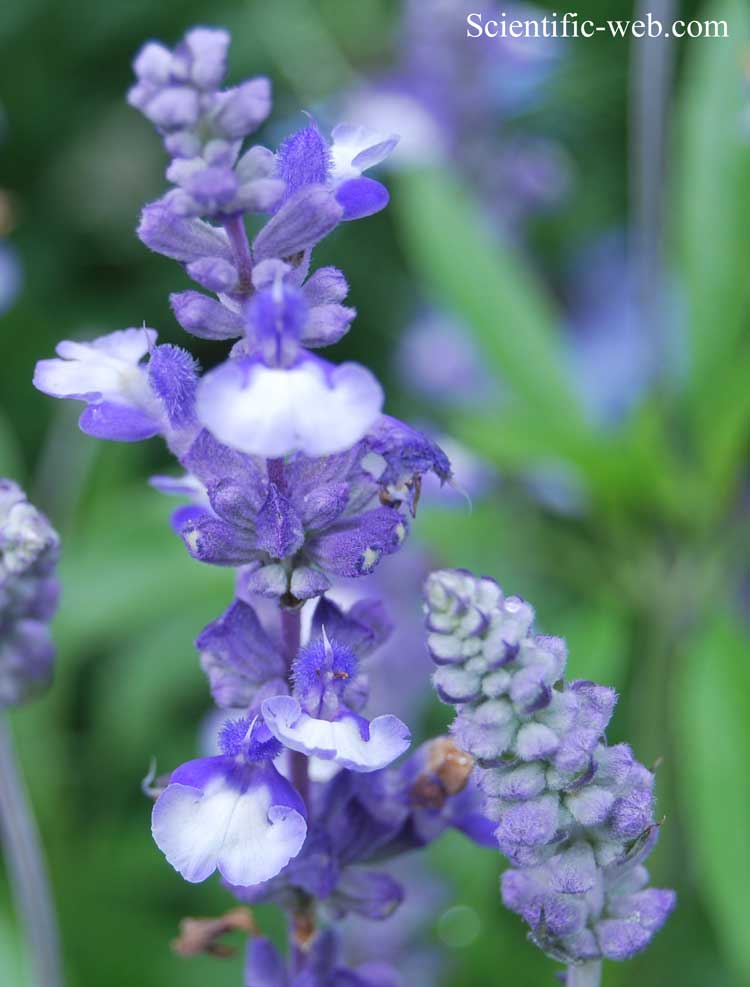
Salvia farinacea, Photo: Michael Lahanas
Classification System: APG IV
Superregnum: Eukaryota
Regnum: Plantae
Cladus: Angiosperms
Cladus: Eudicots
Cladus: Core eudicots
Cladus: Asterids
Cladus: Lamiids
Ordo: Lamiales
Familia: Lamiaceae
Subfamilia: Nepetoideae
Tribus: Mentheae
Subtribus: Salviinae
Genus: Salvia
Subgenus: S. subg. Calosphace
Sectio: S. sect. Farinaceae
Species: Salvia farinacea
Name
Salvia farinacea Benth., Labiat. Gen. Spec. 274. 1833.
Synonyms
Heterotypic
Salvia amabilis K.Koch & C.D.Bouché, Index Seminum (B) 1848: 13. 1848.
Salvia caesia Scheele, Linnaea 22: 588. 1849.
Salvia earlei Wooton & Standl., Contr. U. S. Natl. Herb. 16: 169. 1913.
Salvia farinacea var. heteranthera Brandegee, Univ. Calif. Publ. Bot. 4: 187. 1911.
Salvia farinacea var. latifolia Shinners, Field & Lab. 21: 92. 1953.
Salvia linearis Sessé & Moc., Fl. Mexic.: 6. 1892, nom. illeg. non Ruiz & Pav. (1798).
Salvia trichostyle Bisch., Index Seminum (HEID). 1847.
Salvia virgata Ortega, Nov. Pl. Descr. Dec. 1: 3. 1797, nom. illeg. non Jacq. (1770).
Distribution
Native distribution areas:
Continental: Northern America
Regional: Mexico USA
Mexico Northeast
Regional: Southwern Central USA
New Mexico, Texas
Introduced into:
Connecticut, El Salvador, Florida, Guatemala, India, Louisiana, Ohio, Oklahoma, Trinidad-Tobago, Venezuela
References: Brummitt, R.K. 2001. TDWG – World Geographical Scheme for Recording Plant Distributions, 2nd Edition
References
Primary references
Bentham, G. 1832–1836. Labiatarum genera et species: or, a description of the genera and species of plants of the order Labiatae; with their general history, characters, affinities, and geographical distribution. LXVIII + 783 pp. James Ridgway and Sons, London. Gallica Biblioteca Digital Reference page. : 274.
Additional references
Govaerts, R.H.A. 2003. World Checklist of Selected Plant Families Database in ACCESS: 1-216203. The Board of Trustees of the Royal Botanic Gardens, Kew. [unavailable for the public] Reference page.
Davidse, G. & al. (eds.) (2012). Flora Mesoamericana 4(2): 1-533. Universidad Nacional Autónoma de México, México, D.F.
Links
Govaerts, R. et al. 2022. Salvia farinacea in World Checklist of Selected Plant Families. The Board of Trustees of the Royal Botanic Gardens, Kew. Published online. Accessed: 2022 May 10. Reference page.
Hassler, M. 2022. Salvia farinacea. World Plants: Synonymic Checklists of the Vascular Plants of the World In: Roskovh, Y., Abucay, L., Orrell, T., Nicolson, D., Bailly, N., Kirk, P., Bourgoin, T., DeWalt, R.E., Decock, W., De Wever, A., Nieukerken, E. van, Zarucchi, J. & Penev, L., eds. 2022. Species 2000 & ITIS Catalogue of Life. Published online. Accessed: 2022 May 10. Reference page.
Tropicos.org 2022. Salvia farinacea. Missouri Botanical Garden. Published online. Accessed: 10 May 2022.
International Plant Names Index. 2022. Salvia farinacea. Published online. Accessed: May 10 2022.
Vernacular names
dansk: Texas-Salvie
Deutsch: mehliger Salbei
English: blue sage, mealy sage, mealy-cup sage
suomi: Härmesalvia
français: sauge farineuse
日本語: ケショウサルビア, ブルーサルビア
svenska: daggsalvia
Salvia farinacea, the mealycup sage,[1] or mealy sage,[2] is a herbaceous perennial native to Nuevo León, Mexico and parts of the United States including Texas and Oklahoma.[3] Violet-blue spikes rest on a compact plant of typically narrow salvia-like leaves; however, the shiny leaves are what set this species apart from most other Salvia, which bear velvety-dull leaves.
Description
The mealycup sage reaches stature heights of 60 to 90 cm. The shape of the leaf blade varies from ovate-lanceolate to lanceolate. The inflorescence axis forms a blue, rarely a white hair. The truncated calyx has very short calyx teeth. They are dense blue or white hairy, so that the individual enamel teeth are barely recognisable. The bright blue-white flowers are slim and gleaming. The crown will be about 2.5 inches long. Inside the crown there is no ring-shaped hair strip.
The first description of S. farinacea was made in 1833 by George Bentham in Labiatarum Genera et Species, p. 274. Synonyms for S. farinacea Benth. include Salvia linearis Sessé & Moc. and S. virgata Ortega.[4]
Cultivation
This plant requires full or partial sun and will grow to 18 inches or more with good soil and will attract butterflies and hummingbirds. The plant is hardy to USDA Hardiness Zones 8–10.[5] The plant flowers from June to frost. In the temperate latitudes, it is cultivated as an annual plant and used as an ornamental plant in parks and gardens, especially in summer discounts. It can also be used as a cut flower.
Several cultivars are cultivated, such as 'Blue Bedder', 'Victoria' with intense violet-blue flowers and 'Strata' with white and blue flowers. Crosses between S. farinacea and S. longispicata (S. longispicata × S. farinacea) are widely sold as ornamental plants, such as 'Indigo Spires' and 'Mystic Spires Blue'.[6]
Cultivars
S. farinacea 'Blue Bedder'
S. farinacea 'Strata'
S. farinacea 'Victoria'
Salvia Indigo Spires (S. longispicata × S. farinacea)
Salvia Mystic Spires Blue (S. longispicata × S. farinacea)
Gallery
Salvia farinacea x Salvia longispicata "Mystic Spires Blue'
Bumblebees are very attracted to mealycup sage cultivars
Inflorescence
Natural habitat
Leaves and flowers
Exhibition of Flower Festival, Taichung, Taiwan.
References
USDA, NRCS (n.d.). "Salvia farinacea". The PLANTS Database (plants.usda.gov). Greensboro, North Carolina: National Plant Data Team. Retrieved 28 October 2015.
"Salvia farinacea". Germplasm Resources Information Network (GRIN). Agricultural Research Service (ARS), United States Department of Agriculture (USDA). Retrieved 6 February 2021.
Billie L. Turner. Recension of Salvia sect. Farinaceae (Lamiaceae). Phytologia (August 2008) 90(2) pages 163-175. [1]
Gordon Cheers: Botanica: The ABC of plants. 10,000 species in text and image . German edition. Edition Könemann in the Tandem publishing house Cologne 2003, ISBN 3-89731-900-4 , Salvia farinacea : P. 813.
Missouri Botanical Garden: Salvia farinacea 'Victoria Blue'
Eckehart J. Jäger, Friedrich Ebel, Peter Hanelt, Gerd K. Mueller (Hrsg.): Excursion flora of Germany . Founded by Werner Rothmaler. Volume 5 : Herbaceous ornamental and useful plants . Springer, Spektrum Academic Publisher, Berlin / Heidelberg 2008, ISBN 978-3-8274-0918-8 , p. 512 .
Retrieved from "http://en.wikipedia.org/"
All text is available under the terms of the GNU Free Documentation License

